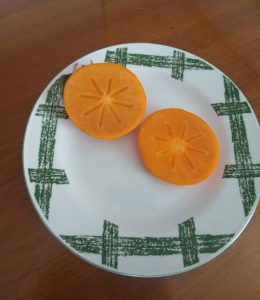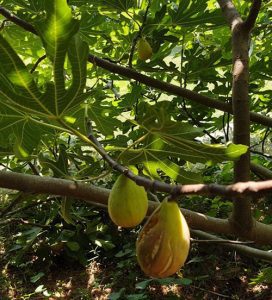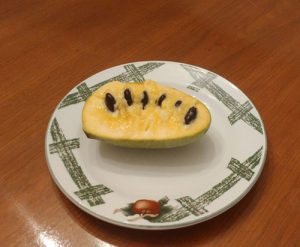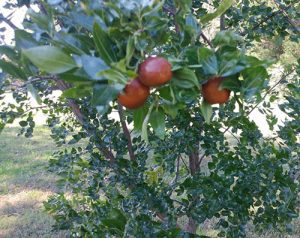Hanover master gardener David Sumner has spent many years learning and experimenting with growing fruits in his Central Virginia garden. In this article, he shares the six easy fruits to grow and will provide delicious fruit for you and your family for years.
As Master Gardeners, we are often asked for advice on how to grow fruit. Usually, the public is interested in the fruits they are familiar with—apples, pears, peaches, plums, and cherries. Due to considerable disease and insect pressures, these fruits are very challenging to grow in central Virginia.
I tried growing apples and pears in my backyard some years ago. I soon encountered a host of diseases and swarms of insects that would devour the leaves and the fruit. After several years of frustration, I removed the diseased trees.
After much experimentation, I have found some fruits that are easy to grow. Some of these fruits are not well known, mainly because they are very perishable and are not commercially viable. Some are cultivars of native fruits and will grow in our area with little care.
I have found that growing these fruits with very little time and effort is possible. With a little planning, we can have fresh fruit from our yards for more than half the year.
Blueberries
Of the popular fruits, blueberries have relatively few disease and insect problems and can easily be grown in the home garden.
They require acidic soil, so a soil test should be done to determine if it should be amended. If needed, sulfur can be added to make the soil more acidic.
Blueberries are shallow-rooted and benefit from a good layer of mulch. Acidic mulches such as pine bark or pine needles can be used to maintain the soil’s acidity. I’ve kept the soil acidic in my garden with a mulch of pine needles and oak and maple leaves.
Blueberries produce best with consistent irrigation, with one inch per week recommended. Annual pruning in early spring to remove the oldest canes will keep the plants vigorous and productive.
There are many varieties of blueberries that ripen at different times. We can harvest blueberries from June through August with a careful selection of varieties.
As a bonus, blueberries also make an attractive ornamental plant.
Figs
Figs can be successfully grown in our area in a sunny location, ideally with some protection, such as a south-facing wall. They will grow in most soils.
Newly planted figs are prone to dieback of the aboveground growth in the coldest part of winter. In the spring, stems will usually regrow from the roots but are unlikely to produce ripe fruit by the end of the season. It is best to plant the hardiest varieties and protect the young plants in the winter. I have had success with two hardy varieties, Hardy Chicago and Brunswick. To protect the plants in winter, I surround them with a cylinder of chicken wire and fill it with leaves. After the first couple of years, the plants will develop thick, woody stems that will survive the winter without protection.
My figs usually ripen about mid-August and continue into the fall. Some varieties can produce two crops in a season. The ‘breba’ crop ripens early on the previous year’s wood. This is followed by the regular crop. I have had figs ripen as early as July 5.
Figs should be picked when they have some color and are nearly or fully ripe. The fruit will droop and hang from the stem when ripe in most varieties. The fruit should be checked frequently for ripeness as it will quickly become overripe and begin to ferment. Also, birds and squirrels will eat the fruit as it ripens.
Paw paws 

The paw paw is a small native fruit tree that grows wild in the understory of our forests. Breeders have improved on the wild paw paw and developed some excellent cultivars.
The cultural requirements of the paw paw are minimal and demand little of the home grower. As an understory tree, the paw paw will grow and produce fruit in partial shade. But it will be most productive in full sun. The young trees are sensitive to the sun and benefit from some shading as they are getting established.
Two or more paw paw trees are needed for pollination. If using cultivars, different varieties must be planted.
The harvest period for paw paws is only a few weeks. In my yard, the fruit ripens from mid-August to early September.
The fruit of the paw paw resembles a mango. When ripe, it is about as soft as an overripe avocado. The flesh is soft and custard-like and eaten with a spoon. The flavor has been described as like vanilla custard with a hint of tropical flavors.
The paw paw makes an attractive ornamental, with its large leaves and tropical-like appearance.
Muscadine grapes
The muscadine grape is a native grape that is very easy to grow. It is well adapted to our southern climate. It grows as a vigorous vine and requires a sturdy trellis for support. Muscadines are enormously productive. The gardener’s most time-consuming task will be picking the fruit.
The grapes are large, tart to very sweet, juicy, with a thick skin. The seeds are bitter and are usually spit out. Nurseries are beginning to offer seedless muscadine grapes. Muscadines come in various colors, from green-gold to iridescent purplish black. Some varieties are self-pollinating. Others will need another variety for pollination.
Some popular varieties I have grown are Fry, a green variety, and Cowart, a purple variety. Fry has a very high sugar content of 21%.
Jujube
The jujube is a small tree from Asia that grows well in hot, dry summers. It makes an attractive ornamental with glossy leaves, a somewhat contorted shape, and thorny branches. It produces a small green fruit which ripens to a rich mahogany, resembling a date. The flesh is crisp and sweet, similar to an apple in taste and texture. The fruit can be dried to concentrate the sweetness, similar to dates. The jujube is easy to grow with no significant pests or diseases.
Persimmon
The persimmon comes in two species that are of interest to the home grower—the American and Asian species. When under-ripe, persimmons are astringent, which is an unpleasant bitter or puckering mouthfeel caused by the tannins in the fruit. But a completely ripe persimmon is among the sweetest of fruits, rivaling dates, with a complex, caramel-like flavor. Persimmons ripen late in the fall and have an attractive habit of hanging on the tree after the leaves have fallen off. The Asian species have non-astringent varieties that can be picked and eaten when not fully ripe, extending the harvest period.
Some excellent hybrids have been developed that combine the qualities of the Asian and American persimmons. The variety I grow, Rossyanka, has the characteristics of the 
 American persimmon but with larger fruit. It holds its fruit well into the winter. I have picked fresh persimmons as late as New Year’s Day.
American persimmon but with larger fruit. It holds its fruit well into the winter. I have picked fresh persimmons as late as New Year’s Day.
The foliage of the persimmon is very attractive in the fall, ranging from yellow to orange or red.
With some careful planning, the home gardener can harvest fresh fruit for most of the year. In my garden, I have harvested blueberries from June into August, paw paws in August and September, figs from August through September, jujubes and muscadine grapes in September, and persimmons from October through December. This is seven months of fresh fruit.
These easy-to-grow fruits have much to offer the home gardener, providing fresh fruit for over half the year with very little effort.
Sources:
https://www.pubs.ext.vt.edu/content/dam/pubs_ext_vt_edu/spes/SPES-316/SPES-316.pdf
https://extension.umd.edu/resource/growing-blueberries-home-garden
https://extension.umd.edu/resource/growing-figs-maryland
https://grapes.ces.ncsu.edu/muscadine_grape_production/
https://plants.ces.ncsu.edu/plants/diospyros-virginiana/
https://www.pubs.ext.vt.edu/426/426-840/426-840.html






